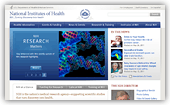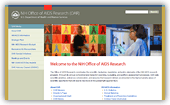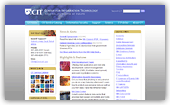Need a creative, clean, professionally designed website? CIT is your central source at NIH for website design and development, from small projects to high-profile trans-NIH initiatives. Our process includes gathering requirements, assisting with organizing your content, creating custom-designed prototypes, coding the HTML and CSS, importing the content, and maintaining your website on a continuing basis. Our talented designers have developed many websites across NIH and have years of experience with Web and user-interface design. We offer advice and suggestions based on real-world scenarios. You can rest assured that we’re experts in dealing with usability, Web standards, and best practices. We’re also familiar with HHS policies and other federal regulations such as Section 508 (accessibility for people with disabilities) that must be considered when building a government website. We take pride in our customer service, and you’ll enjoy a responsive, accommodating relationship. Whether you know exactly what you want or haven’t a clue, you can rely on us. The National Institutes of Health is the most prestigious medical research agency in the world. Shouldn’t your website show it? Here’s how it works: - Requirements gathering — The first step in developing a website is to discuss your needs and determine the scope of the project. We usually do this face-to-face, although phone or e-mail may be sufficient for small projects.
- Cost estimate — Since we’re fee-for-service, we provide you with a written cost estimate and proposed timeline based on your requirements. Please note that although we can coordinate domain name setup, Website hosting, search functionality, NIH Login authentication, and WebTrends reporting, these services are provided by other groups and are billed separately.
- Customer approval — We begin work after you approve the estimate and provide a CIT account number for billing. If you don’t know it, we may be able to determine the account number based on your Common Account Number (CAN).
- Information architecture — We can help you take inventory and figure out how to organize the information on your site in a way that will make it easy for your visitors to find what they’re looking for.
- Wireframes — Before we begin any design work, we determine how content will be arranged on representative page types.
- Design — We create several design concepts. These are typically Photoshop mock-ups that convey the look-and-feel of your site. Most likely we’ll go through several rounds of revisions.
- Development — Now we roll up our sleeves and code the HTML page templates and Cascading Style Sheets (CSS), testing for consistency with various Web browsers.
- Content migration — Once the page templates are finalized, it’s time to import all your content into the new design. This is the fun part, where you see your site take shape. We also test to ensure your site conforms with Section 508.
- Review — At this point you have the opportunity to go through the entire site to make sure everything is in working order. We fix any issues and do some final testing.
- Launch — We “flip the switch” on a date and at a time you determine, and your new website becomes available to the public.
- Maintenance — We can maintain your site on an ongoing basis after it goes live. Turn-around time depends on the level of effort involved, but you’ll find our service responsive and convenient.
For inquiries, please contact Richard Barnes
Program Manager, Web Design Services Team
Custom Applications Branch
Division of Enterprise and Custom Applications, CIT
richardb@mail.nih.gov | 






|